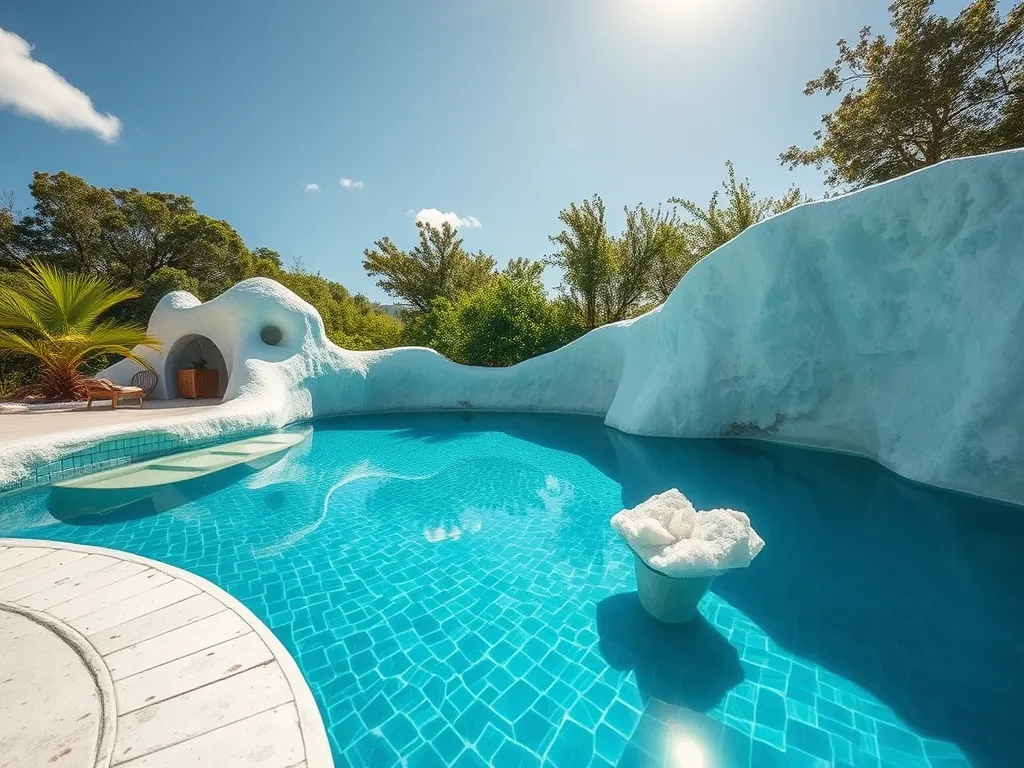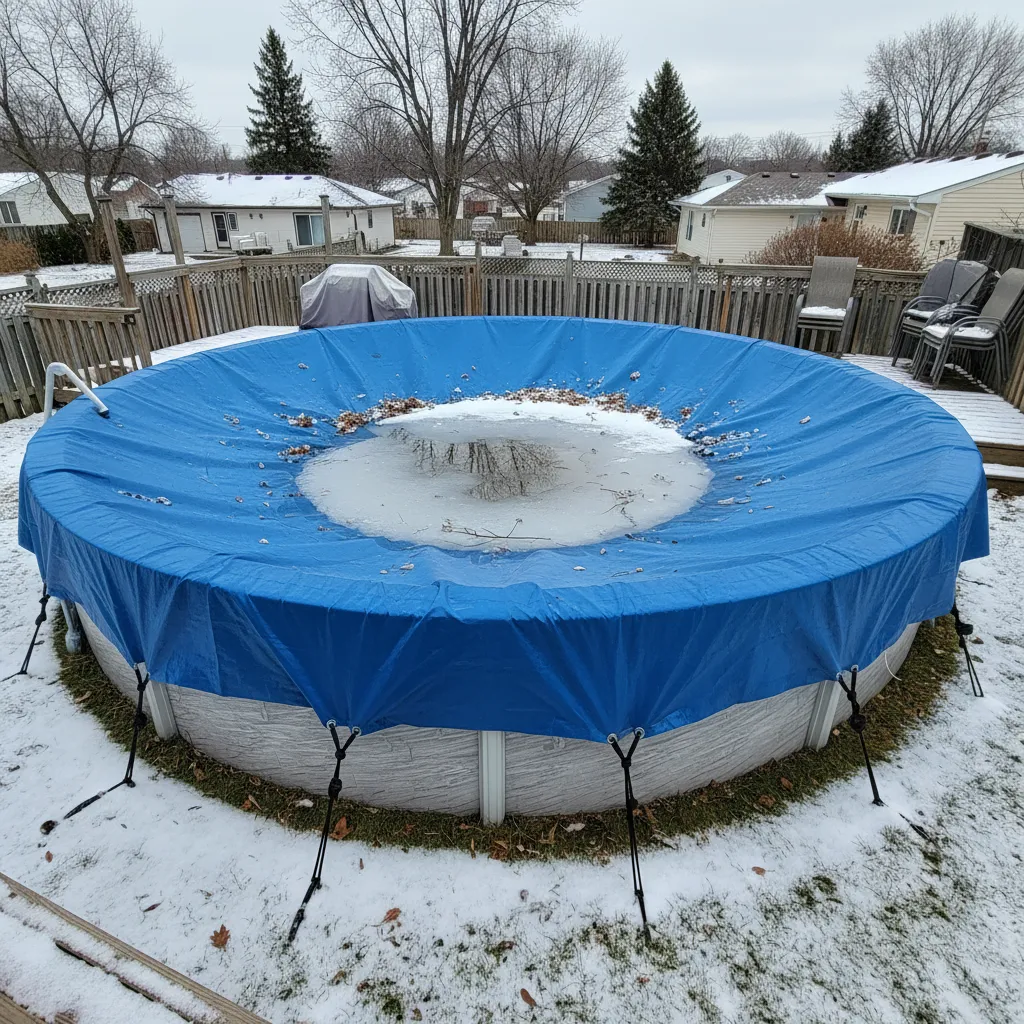Salt Calculator for Pools: Keep Your Water Balanced
Published on: April 9, 2025 | Last Updated: April 13, 2025
Written By: Marcus Thornfield
A saltwater pool needs the right salt levels to stay clean and safe. Too little salt and your chlorinator won’t work. Too much salt can damage equipment. This calculator helps you find how much salt to add. Just plug in your pool’s details below!
Pool Salt Calculator
How to Use This Calculator
- Find your pool’s volume in gallons (check manual or pool wall)
- Test current salt level with test strips or digital reader
- Enter numbers above (target is usually 3200 ppm)
- Click “Calculate Salt Needed”
Note: Always add less than full amount first, wait 24 hours, then retest. Rain, splashing, or backwashing affects salt levels.
Crucial Winterizing Products
"The all-in-one solution for a guaranteed clear spring opening."
All-in-One Closing Chemical Kit
Winter demand is high - check stock
"The 'set & forget' option. This is the easiest winterizing I've ever done."
Simple 3-in-1 Winterizing Balls
Winter demand is high - check stock
"Invest once to protect your liner and prevent a swamp in the spring."
Heavy-Duty Winter Pool Cover
Winter demand is high - check stock
Salt Requirements for Pools: Key Factors Affecting Salt Quantity
Managing salt levels in a pool requires precision. The ideal salinity range is 2700-3400 ppm (parts per million), with 3200 ppm as the optimal target. Four primary factors determine salt needs: pool volume, current salinity, salt type, and environmental conditions. Keeping the salt level in the ideal range can enhance the swimming experience. An ideal salt level pool helps maintain clear water and reduces chemical usage.
Pool Volume and Dimensions
Water capacity directly impacts salt demand. Standard measurement methods include:
- Rectangular pools: Length (ft) × Width (ft) × Average Depth (ft) × 7.5 = Gallons
- Circular pools: Diameter (ft) × Diameter (ft) × Average Depth (ft) × 5.9 = Gallons
- Oval pools: Long Diameter (ft) × Short Diameter (ft) × Average Depth (ft) × 6.7 = Gallons
For example, a 16×32 ft rectangular pool with 4.5 ft depth holds 16×32×4.5×7.5 = 17,280 gallons. Salt systems require this data to compute dosage accurately.
Current Salinity Levels
Test salinity weekly using:
- Digital salinity meters (accuracy ±200 ppm)
- Test strips (accuracy ±400 ppm)
- Professional water analysis (lab-grade precision)
If current salt concentration is 1800 ppm and the target is 3200 ppm, the required increase is 1400 ppm. For a 20,000-gallon pool: 20,000 × 0.0014 (1400 ppm) = 28 pounds of salt needed. Saltwater pools can be a great alternative to traditional chlorine pools. Converting a pool to saltwater involves ensuring the proper salt levels and installing a salt chlorine generator.
Salt Types and Purity Grades
| Type | Purity | Cost per 40lb Bag | Best For |
|---|---|---|---|
| Sodium Chloride (Solar) | 99.8% | $7-$9 | All saltwater pools |
| Sodium Chloride (Mined) | 99.6% | $6-$8 | Indoor pools |
| Potassium Chloride | 99.9% | $25-$30 | Low-sodium systems |
| Magnesium Chloride | 98% | $15-$20 | Therapeutic pools |
Impurities in lower-grade salts (≤95% purity) can cause scaling and chlorine generator damage. Always verify NaCl content before purchase.
Environmental Variables
Salt depletion occurs through:
- Backwashing (loses 50-200 ppm per cycle)
- Splash-out (1” water loss = 620 ppm reduction in 20k gal pool)
- Rainwater dilution (1” rain in 20k gal pool lowers salinity by 12%)
- Evaporation (no salt loss, but concentrates other minerals)
Heavy rainfall (≥3 inches) typically requires 5-7 lbs of salt per 1000 gallons to rebalance. Check My Pool Calculator for location-specific weather adjustments.
Salt Quantity Guidelines by Pool Size
Standard salt requirements per 1000 ppm increase:
| Pool Volume | Salt Needed | 40lb Bags Required |
|---|---|---|
| 10,000 gal | 83 lbs | 2.08 |
| 15,000 gal | 125 lbs | 3.13 |
| 20,000 gal | 167 lbs | 4.18 |
| 25,000 gal | 208 lbs | 5.20 |
These figures assume 100% pure NaCl. For 99% pure salt, multiply results by 1.01. For 95% purity, multiply by 1.05.
Salt Additions for New Pools
Initial salinization requires:
- Plaster pools: 3200 ppm base + 500 ppm buffer = 3700 ppm
- Fiberglass pools: 3200 ppm + 300 ppm buffer = 3500 ppm
- Vinyl liner pools: 3200 ppm + 200 ppm buffer = 3400 ppm
Buffers account for material absorption. Test after 24 hours of circulation before activating the chlorine generator.
Also See: Pool Shock Dosage Calculator for Clear Water

Maintenance: Adjusting Existing Salt Levels
Weekly salt loss averages:
- Residential pools: 50-100 ppm/week
- Commercial pools: 150-300 ppm/week
To raise salinity by 500 ppm in a 15,000-gallon pool: 15 × 8.35 lbs (per 1000 gal) × 0.5 = 62.6 lbs of salt. Always add 10% less than calculated, then retest after 4 hours of pump runtime. This is an important step for pools that are converting to saltwater systems. Proper salinity levels help keep the pool water clean and balanced.
Reducing Excess Salinity
Methods to lower salt concentration:
- Partial drain/refill: Most effective (removes 50% salt with 50% water replacement)
- Reverse osmosis filtration: Costs $300-$600 but preserves water
- Natural dilution: Relies on rainfall (1” rain ≈ 10% salinity reduction)
Saltwater Pool Chemistry Interactions
Salinity affects other parameters:
| Parameter | Effect of High Salt | Effect of Low Salt |
|---|---|---|
| Chlorine Production | Corrodes cells | Reduces output |
| pH Stability | Increases pH drift | Improves stability |
| Total Alkalinity | Requires +20 ppm buffer | Standard levels |
| Calcium Hardness | Accelerates scaling | Reduces scaling risk |
Maintain calcium hardness at 200-400 ppm and total alkalinity at 80-120 ppm for balanced saltwater chemistry.
Regional Considerations for Salt Management
Humidity and Evaporation Rates
High-humidity areas (≥70% RH):
- Salt loss: 30-50 ppm/month
- Evaporation rate: 0.1”/day
Arid climates (≤30% RH):
- Salt loss: 100-150 ppm/month
- Evaporation rate: 0.3”/day
Winterization Procedures
In freezing climates:
- Test salinity monthly under ice cover
- Maintain ≥2800 ppm to prevent line freezing
- Use calcium chloride instead of salt if temps drop below 15°F

Equipment-specific Salt Requirements
Chlorine Generator Compatibility
| Brand | Minimum Salt | Maximum Salt | Ideal Range |
|---|---|---|---|
| Hayward | 2600 ppm | 3400 ppm | 3000-3200 ppm |
| Pentair | 2800 ppm | 4500 ppm | 3200-3500 ppm |
| Jandy | 2700 ppm | 3400 ppm | 3000-3200 ppm |
Exceeding manufacturer limits voids warranties. Consult My Pool Calculator for brand-specific guides.
Cost Analysis: Salt Vs Traditional Chlorine
Annual cost comparison for 20k gal pool:
- Salt system: $150-$300 (salt + cell replacement)
- Liquid chlorine: $400-$600
- Tablets: $500-$800
Salt systems break even in 2-3 years. Factor in $200-$700 for replacement cells every 3-7 years.
FAQs: Salt Management in Pools
Can I Use Water Softener Salt?
Only if it’s 99.4% pure NaCl without additives. Avoid yellow-tinted salts containing ferrocyanide.
How Long After Adding Salt Can I Swim?
Wait until full dissolution – typically 4-6 hours with pump running. Brush any undissolved salt from pool floors.
Does Salt Damage Pool Surfaces?
Properly maintained saltwater (≤3400 ppm) won’t harm modern plaster or composites. Levels above 5000 ppm risk corrosion.
Why Does My Salt Reading Fluctuate?
Temperature changes alter conductivity readings. Calibrate meters at 77°F. Cold water (≤60°F) shows 10-15% lower salinity.
How Often Should I Replace Salt?
Salt doesn’t expire. Only replace losses from backwashing, splash-out, or draining. Top up as needed.
For precise adjustments to your specific pool conditions, visit My Pool Calculator to access advanced algorithms that account for local water tables, equipment specs, and seasonal variations.
Useful References for You:
- Tamminen, T. (2019). The Complete Pool Manual for Homeowners: A Step-by-Step Maintenance Guide. New York, NY: Skyhorse Publishing.
- PoolMath
- Pool Salt PPM Calculator - Quick Easy Suite of Pool Chemical Calculators
- Water Chemistry Calculator
- Pool Salt Calculator - HomeAdvisor





